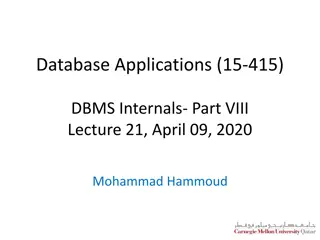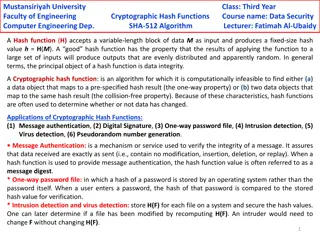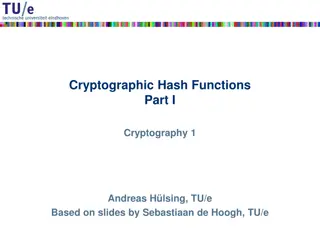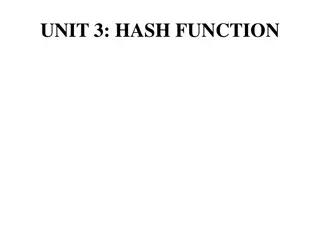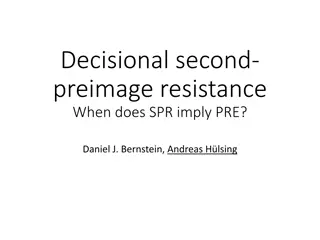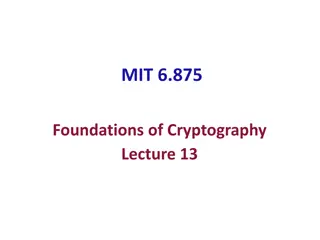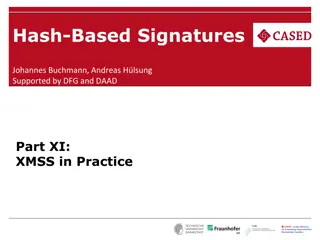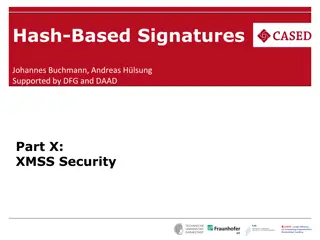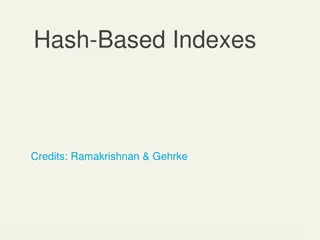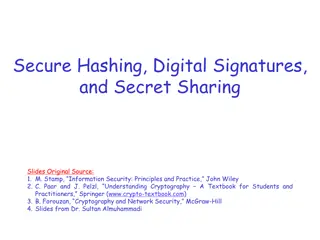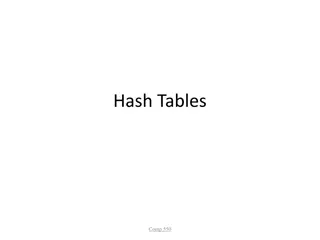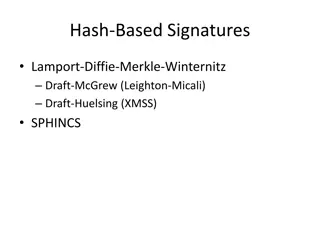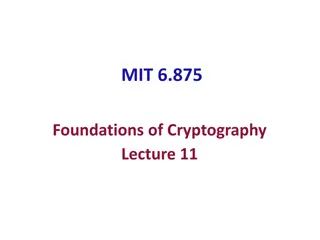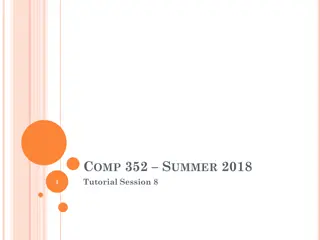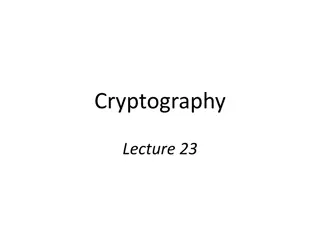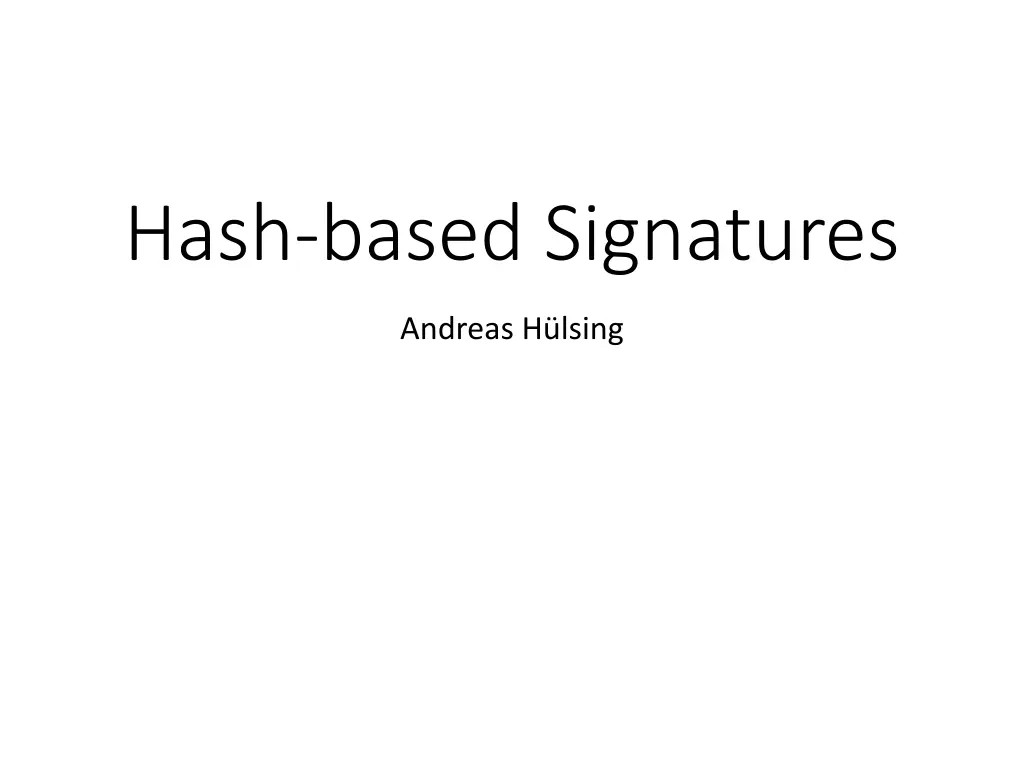
Understanding Post-Quantum Signatures and Hash-Based Schemes
Explore the intricacies of post-quantum signatures, lattice-based schemes, and hash functions in a post-quantum computing world. Delve into topics like collision resistance, second-preimage resistance, and pseudorandomness for enhanced understanding and security. Discover the vulnerabilities and strengths of different cryptographic hash functions like MD5, SHA-1, RSA, and more. Stay informed about the latest advancements and security measures in the realm of cryptographic algorithms and digital signatures.
Download Presentation

Please find below an Image/Link to download the presentation.
The content on the website is provided AS IS for your information and personal use only. It may not be sold, licensed, or shared on other websites without obtaining consent from the author. If you encounter any issues during the download, it is possible that the publisher has removed the file from their server.
You are allowed to download the files provided on this website for personal or commercial use, subject to the condition that they are used lawfully. All files are the property of their respective owners.
The content on the website is provided AS IS for your information and personal use only. It may not be sold, licensed, or shared on other websites without obtaining consent from the author.
E N D
Presentation Transcript
Hash-based Signatures Andreas H lsing
Post-Quantum Signatures Lattice, MQ, Coding Signature and/or key sizes = + + + 2 1 y x x x x x x 1 1 2 1 4 3 x = + + + + 2 3 1 y x x x x x 2 2 3 2 4 1 = ... y 3 Runtimes Secure parameters 9-5-2025 PAGE 2
Hash-based Signature Schemes [Mer89] Post quantum Only secure hash function Security well understood Fast 9-5-2025 PAGE 3
RSA DSA EC-DSA... Intractability Assumption Cryptographic hash function RSA, DH, SVP, MQ, Digital signature scheme 9-5-2025 PAGE 4
(Hash) function families ?? ?:{0,1}? ? {0,1}? {0,1}? ?(?) ? ? efficient {0,1}? ?
One-wayness ?? ?:{0,1}? ? {0,1}? ??,? $?? ${0,1}? ? ? ? ?? ?? Success if ?? = ?? ?
Collision resistance ?? ?:{0,1}? ? {0,1}? ? $?? ? Success if ??1 = ??2 ,?2 ) (?1
Second-preimage resistance ?? ?:{0,1}? ? {0,1}? ??,? $?? ${0,1}? ? ? ?? Success if ??? = ?? ?
Undetectability ?? ?:{0,1}? ? {0,1}? ? ? If ? = 1 ${0,1}? ? ?? ?(?) else ${0,1}? ??,? $?? ${0,1} ? ?* ??
Pseudorandomness ?? ?:{0,1}? ? {0,1}? 1? ? If ? = 1 $?? else $?? ? ,? ? ? g ? = ?(?) ? ?*
Hash-function properties stronger / easier to break Collision-Resistance Assumption / 2nd-Preimage- Resistance Attacks Pseudorandom One-way weaker / harder to break 9-5-2025 PAGE 11
Attacks on Hash Functions MD5 MD5 Collisions (practical!) Collisions (theo.) SHA-1 Collisions (theo.) MD5 & SHA-1 No (Second-) Preimage Attacks! 2004 2005 2008 2015 9-5-2025 PAGE 12
Basic Construction 9-5-2025 PAGE 13
Lamport-Diffie OTS [Lam79] Message M = b1, ,bm, OWF H = n bit * SK sk1,0 sk1,1 skm,0 skm,1 H H H H H H PK pk1,0 pk1,1 pkm,0 pkm,1 bm b1 b2 Mux Mux Mux Sig sk1,b1 skm,bm 9-5-2025 PAGE 14
EU-CMA for OTS ?? ??,1? ? SIGN (?,?) Success if ? ? and Verify ??,? ,? = Accept (? ,? ) 23.09.2013 | TU Darmstadt | Andreas H lsing | 15
Security Theorem: If H is one-way then LD-OTS is one-time eu-cma- secure.
Reduction Input: ??,? Set ? ? Replace random pki,b sk1,0 sk1,1 skm,0 skm,1 H H H H H H ?? pk1,0 pk1,1 pkm,0 pkm,1
Reduction Adv. Message: M = b1, ,bm If bi = b return fail else return Sign(M) Input: ??,? Set ? ? Replace random pki,b ? sk1,0 sk1,1 skm,0 skm,1 H H H H H ?? pk1,0 pk1,1 pkm,0 pkm,1 bm b1 b2 Mux Mux Mux sk1,b1 skm,bm
Reduction Forgery: M* = b1*, ,bm*, ? = ?1, ,?? If bi b return fail Else return ?? Input: ??,? Set ? ? Choose random pki,b ? ?? ?? sk1,0 sk1,1 skm,0 skm,1 H H H H H ?? pk1,0 pk1,1 pkm,0 pkm,1
Reduction - Analysis Abort in two cases: 1. bi = b probability : b is a random bit 2. bi b probability 1 - 1/m: At least one bit has to flip as M* M Reduction succeeds with A s success probability times 1/2m.
Merkles Hash-based Signatures PK SIG = (i=2, , , , , ) H H H OTS H H H H H H H H H H H H OTS OTS OTS OTS OTS OTS OTS OTS SK 9-5-2025 PAGE 21
Security Theorem: MSS is eu-cma-secure if OTS is a one-time eu-cma secure signature scheme and H is a random element from a family of collision resistant hash functions.
Reduction Input: ?,????? 1. Choose random 0 ? < 2 2. Generate key pair using ?????as ?th OTS public key and ? ? 3. Answer all signature queries using sk or sign oracle (for index ?) 4. Extract OTS-forgery or collision from forgery
Reduction (Step 4, Extraction) Forgery: (? ,???? 1. If ????? an OTS forgery. Can only be used if ? = ?. 2. Else adversary used different OTS pk. Hence, different leaves. Still same root! Pigeon-hole principle: Collision on path to root. ,????? , AUTH) equals OTS pk we used for ? OTS, we got
Recap LD-OTS [Lam79] * MessageM = b1, ,bm, OWF H = n bit SK sk1,0 sk1,1 skm,0 skm,1 H H H H H H PK pk1,0 pk1,1 pkm,0 pkm,1 b1 b2 bn Mux Mux Mux sk1,b1 skm,bm Sig
LD-OTS in MSS SIG = (i=2, , , , , ) Verification: 1. Verify 2. Verify authenticity of We can do better!
Trivial Optimization MessageM = b1, ,bm, OWF H = n bit * SK sk1,0 sk1,1 skm,0 skm,1 H H H H H H PK pk1,0 pk1,1 pkm,0 pkm,1 bm b1 bm b1 Mux Mux Mux Mux Sig sigm,0 sig1,0 sigm,1 sig1,1
Optimized LD-OTS in MSS X SIG = (i=2, , , , , ) Verification: 1. Compute from 2. Verify authenticity of Steps 1 + 2 together verify
Germans love their Ordnung! Message M = b1, ,bm, OWF H SK: sk1, ,skm,skm+1, ,sk2m PK: H(sk1), ,H(skm),H(skm+1), ,H(sk2m) Encode M: M = M|| M = b1, ,bm, b1, , bm (instead of b1, b1, ,bm, bm ) ski , if bi = 1 Sig: sigi = H(ski) , otherwise Checksum with bad performance!
Optimized LD-OTS Message M = b1, ,bm, OWF H SK: sk1, ,skm,skm+1, ,skm+log m PK: H(sk1), ,H(skm),H(skm+1), ,H(skm+log m) Encode M: M = b1, ,bm, 1 ??? ski , if bi = 1 Sig: sigi = H(ski) , otherwise IF one biis flipped from 1 to 0, another bjwill flip from 0 to 1
Function chains Function family: ?? ?:{0,1}? {0,1}? ? Parameter ? Chain: k c h x c = ( ) ( $?? = 1 i i ( )) ( ) x h h h x k k k times i c0(x) = x ?? ?(?) ?1(?) = ?(?)
WOTS Winternitz parameter w, security parameter n, message length m, function family ?? Key Generation: Compute ?, sample ? c0(sk1) = sk1 pk1 = cw-1(sk1) c1(sk1) c1(skll ) pkll= cw-1(skll ) c0(skll ) = skll
WOTS Signature generation M b1 b2 b3 b4 bm bll bm +1 bm +2 pk1 = cw-1(sk1) c0(sk1) = sk1 C 1=cb1(sk1) Signature: = ( 1, , ll) pkll= cw-1(skll ) c0(skll ) = skll ll=cbll(skll)
WOTS Signature Verification Verifier knows: M, w b1 b2 b3 b4 bm bll bm +1 bll 1+2 pk1 ??( 1) ??( 1) =? 1 ??( 1) ?? ? ??( 1) Signature: = ( 1, , ll) pkll =? ?? ? ??( ll) ll
WOTS Function Chains For ? 0,1?define ?0? = ? and WOTS: ??? = ?(?? 1? ) WOTS$: ??? = ?? 1?(?) WOTS+: ??? = ?(?? 1? ??)
WOTS Security Theorem (informally): W-OTS is strongly unforgeable under chosen message attacks if ?? is a collision resistant family of undetectable one-way functions. W-OTS$is existentially unforgeable under chosen message attacks if ?? is a pseudorandom function family. W-OTS+is strongly unforgeable under chosen message attacks if ?? is a 2nd-preimage resistant family of undetectable one-way functions.
XMSS Tree: Uses bitmasks H Leafs: Use binary tree with bitmasks H OTS: WOTS+ bi Mesage digest: Randomized hashing Collision-resilient -> signature size halved
Multi-Tree XMSS Uses multiple layers of trees -> Key generation (= Building first tree on each layer) (2h) (d*2h/d) -> Allows to reduce worst-case signing times (h/2) (h/2d)
Protest? PAGE 43 9-5-2025
Few-Time Signature Schemes 9-5-2025 PAGE 44
Recap LD-OTS Message M = b1, ,bn, OWF H = n bit * SK sk1,0 sk1,1 skn,0 skn,1 H H H H H H PK pk1,0 pk1,1 pkn,0 pkn,1 b1 b2 bn Mux Mux Mux sk1,b1 skn,bn Sig 9-5-2025 PAGE 45
HORS [RR02] Message M, OWF H, CRHF H = n bit Parameters t=2a,k, with m = ka (typical a=16, k=32) * SK sk1 sk2 skt-1 skt H H H H H H PK pk1 pk1 pkt-1 pkt 9-5-2025 PAGE 46
HORS mapping function Message M, OWF H, CRHF H = n bit Parameters t=2a,k, with m = ka (typical a=16, k=32) * M H b1 b2 ba bar ik i1 9-5-2025 PAGE 47
HORS Message M, OWF H, CRHF H = n bit Parameters t=2a,k, with m = ka (typical a=16, k=32) * SK sk1 sk2 skt-1 skt H H H H H H PK pk1 pk1 pkt-1 pkt H (M) b1 b2 ba ba+1 bka-2bka-1 bka i1 ik Mux Mux skik ski1 9-5-2025 PAGE 48
HORS Security ? mapped to ? element index set ?? {1, ,?}? Each signature publishes ? out of ? secrets Either break one-wayness or ?for ? r-Subset-Resilience: After seeing index sets ?? messages ????,1 ? ?, hard to find ????+1 ???? such that ??+1 1 ? ??? ?. ? ? ?? ? Best generic attack: Succr-SSR(?,?) = ? Security shrinks with each signature! 9-5-2025 PAGE 49
HORST Using HORS with MSS requires adding PK (tn) to MSS signature. HORST: Merkle Tree on top of HORS-PK New PK = Root Publish Authentication Paths for HORS signature values PK can be computed from Sig With optimizations: tn (k(log t x + 1) + 2x)n E.g. SPHINCS-256: 2 MB 16 KB Use randomized message hash 9-5-2025 PAGE 50
SPHINCS Stateless Scheme XMSSMT + HORST + (pseudo-)random index Collision-resilient Deterministic signing SPHINCS-256: 128-bit post-quantum secure Hundrest of signatures / sec 41 kb signature 1 kb keys

